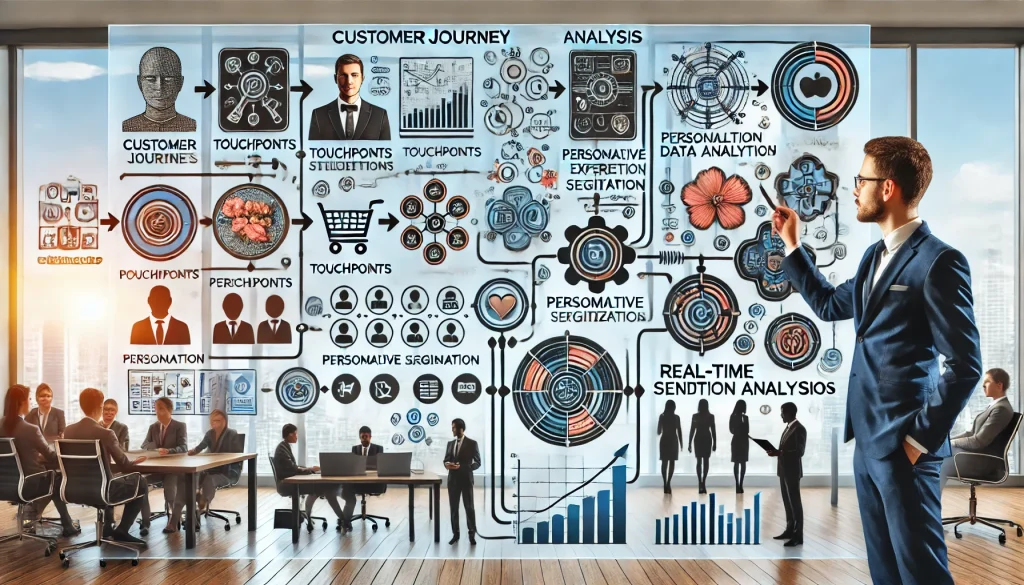Introduction
In the fiercely competitive landscape of modern business, comprehending the customer journey is essential for organizations striving to elevate customer experience and stimulate growth. Customer journey analysis encompasses the process of delineating and examining the various phases a customer traverses while engaging with a brand. This includes pinpointing touchpoints, grasping customer behaviors, and evaluating the success of marketing strategies at every stage.
As consumers become increasingly selective and their expectations escalate, brands are compelled to focus on delivering tailored and cohesive experiences. This article explores the significance of customer journey analysis, highlights current trends, discusses crucial aspects, identifies the target audience, and presents best practices for successful implementation.

Current Trends in Customer Journey Analysis
- Merging AI with Human Interaction
As artificial intelligence (AI) continues to permeate customer service, brands must not underestimate the value of empathy-driven experiences. While AI can enhance efficiency and offer analytical insights, preserving a human element in interactions is vital for nurturing authentic relationships with customers. Companies are discovering that a combination of cutting-edge technology and compassionate service leads to a more rewarding customer experience.
- Personalization in Customer Experience
The impact of data on customizing customer interactions is profound. Brands are harnessing data analytics to gain deeper insights into customer preferences and behaviors, allowing them to tailor communications, promotions, and product suggestions accordingly. This level of personalization significantly boosts customer satisfaction and loyalty, making it a prominent trend in customer journey analysis.
- Rise of Immersive Experiences
Augmented reality (AR) and virtual reality (VR) are transforming customer journeys. These immersive technologies empower brands to create distinct experiences that engage customers more profoundly. For instance, furniture retailers are using AR to let customers visualize how products would appear in their homes, greatly enhancing the decision-making process.
- Sentiment Analysis and Immediate Feedback
Utilizing technology to assess customer sentiment is gaining importance. Real-time feedback tools, powered by AI, enable businesses to measure customer satisfaction right after interactions. This capability allows brands to promptly address issues and modify their strategies based on customer input, fostering ongoing enhancement of the customer journey.
- Advanced Techniques for Customer Journey Mapping
The methods for visualizing customer journeys are advancing. Traditional linear journey maps are gradually being supplanted by dynamic, interactive models that reflect the complexity of customer interactions across various channels. Companies are adopting sophisticated mapping tools that integrate real-time data, allowing them to visualize and refine their customer journeys more effectively.
Essential Elements of Customer Journey Analysis
Grasping the essential elements of customer journey analysis is crucial for businesses aiming to refine their strategies:
- Touchpoints and Customer Interactions: Recognizing all touchpoints where customers connect with the brand is the initial step in understanding the journey. Each touchpoint offers a chance to enhance the customer experience.
- Customer Segmentation: Customers are not a monolith. Segmenting them based on demographics, behaviors, and preferences facilitates more targeted and effective marketing strategies.
- Customer Personas: Crafting detailed customer personas aids businesses in visualizing their target audience. These personas inform marketing tactics and ensure that messaging resonates with specific customer segments.
- Continuous Analysis and Adaptation: The customer journey is dynamic. Ongoing analysis and adaptation empower businesses to respond to evolving customer behaviors and preferences, ensuring they stay relevant and competitive.

Target Audience
- Primary Audience: Marketing and Customer Experience Professionals
These individuals focus on enhancing customer satisfaction and comprehending customer behavior. They are keen on utilizing data for informed decision-making and improving the overall customer experience.
- Secondary Audience: Business Owners and Executives
This group primarily seeks to boost revenue through enhanced customer experiences and gain a competitive edge via insightful customer data.
Best Practices for Executing Customer Journey Analysis
To implement customer journey analysis effectively, businesses should adhere to certain best practices:
- Creating Customer Personas
Developing comprehensive customer personas is vital for accurately representing target customers. By understanding their needs, challenges, and motivations, businesses can tailor their marketing initiatives and enhance customer engagement.
- Utilizing Customer Journey Maps
A well-crafted customer journey map visually illustrates the various stages customers experience, from awareness to post-purchase. By employing tools and frameworks to create these maps, businesses can derive valuable insights into customer experiences and pinpoint areas for enhancement.
- Embracing Continuous Improvement Through Feedback
Integrating customer feedback into the ongoing assessment of the customer journey is crucial. Regularly gathering feedback through surveys, reviews, and direct interactions enables businesses to make informed adjustments to their strategies, thereby improving the overall customer experience.
Conclusion
Grasping the nuances of customer journey analysis is pivotal for businesses aspiring to thrive in today’s competitive environment. By keeping abreast of the latest trends, acknowledging the essential elements of customer interactions, and implementing best practices, companies can forge meaningful and enduring relationships with their customers.
As businesses invest in understanding their customers, they not only meet but exceed expectations, ultimately driving loyalty and revenue growth.




